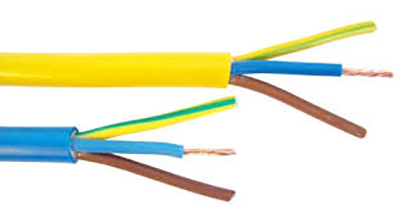PVC Cable Applications
 In plasticized PVC products, both coated and uncoated calcium carbonate fillers are included according to the type of application (cable, flooring, profiles, films) and the type of plasticizer.
In plasticized PVC products, both coated and uncoated calcium carbonate fillers are included according to the type of application (cable, flooring, profiles, films) and the type of plasticizer.
For example, there are three different basic applications in cable production; insulation, sheathing and filling mixtures. Practical trials have shown that favorable mechanical and electrical properties are only possible with calcium carbonate. Statistical diameters of these fillings should be around 2 microns. In the average particle size distribution, the ball cut value should not exceed 10 microns.
The fill rate in the cables depends on the usage area of the cable. Today, low voltage cables (up to 1000V) are usually insulated with PVC. The lifetime of an insulation mixture should not be less than 30 years under electrical, mechanical and thermal loads. To ensure this time in low voltage cables, the amount of calcium carbonate should not exceed 40% for operating temperatures below 105 °C and 25% for higher temperatures. For medium voltage cables (1000-10000 V), a maximum of 10% calcium carbonate filler should be used. For such requirements, calcined kaolin is also added as an ion scavenger. The aim here is to absorb the cations in the PVC mixture and make them ready. In this way, the insulating properties of the formula are improved. High voltage cables are not insulated with PVC.
Normal cable sheaths contain between 40% and 50% calcium carbonate. In this case, the filler significantly improves the flow properties, so the extrusion properties also improve as the capacity increases. In addition, much better thermal conductivity is obtained in the final product compared to unfilled plastics. Thus, the distribution of electricity to the environment can be much better thanks to the heat generation in the electricity transfer.
Gaps between insulated electrical contacts are filled with filler mixtures. These mixtures are not expected to meet any mechanical requirements. For this reason, it is possible to enter 90% filling into the mixture. Of course, prices also have an effect on this preference. Particularly preferred cable filler mixtures are PVC wastes or highly filled rubbers such as EPDM.
Outside of the cable industry, flexible PVC is also very important for flooring and profile extrusion. Flexible PVC profiles are generally used in the automotive industry as corner protection strips, decorative ornaments, and in the construction industry as splicing tape and edge board. But refrigerator seals and flexible tubes are also made of PCV today. The amount of filling in these products is between 15% and 45% on average.
